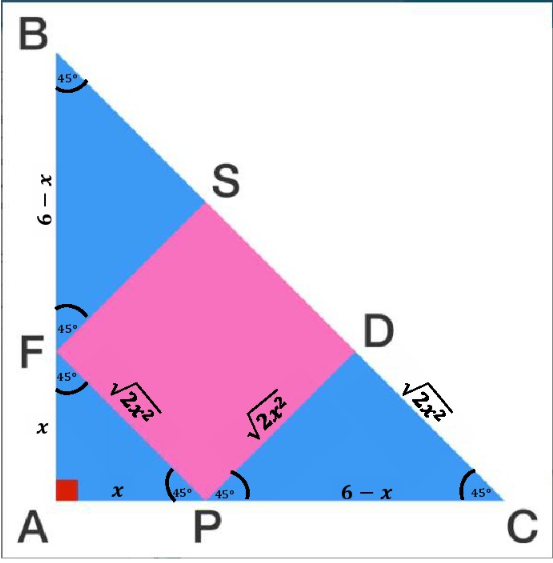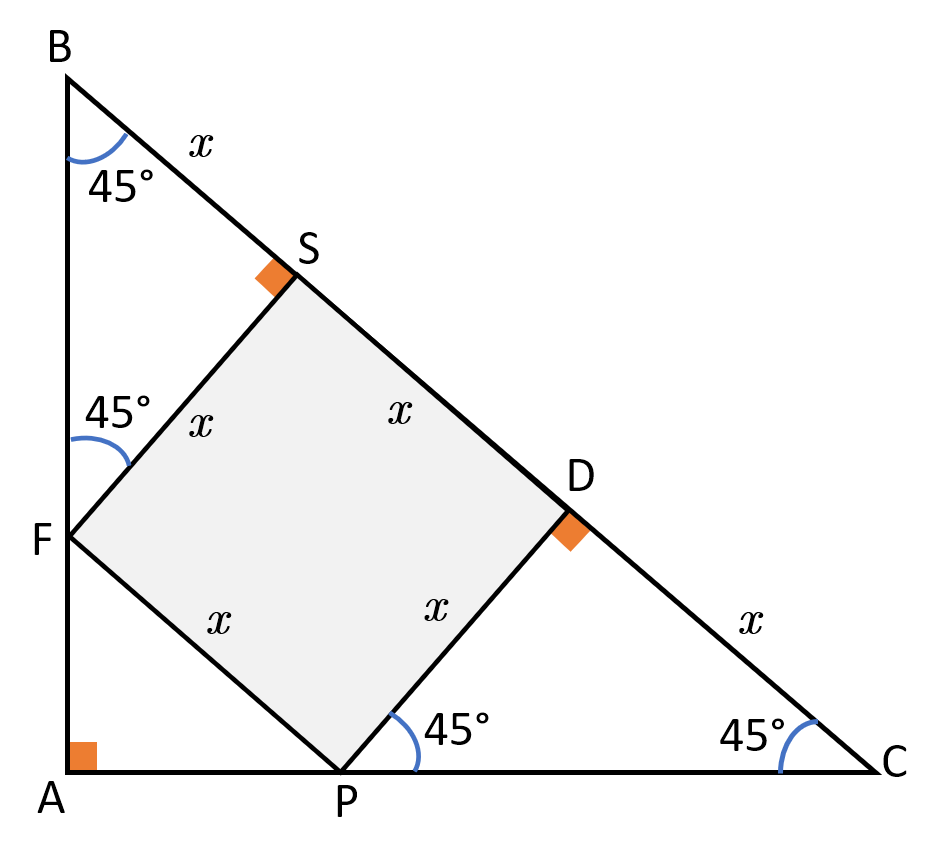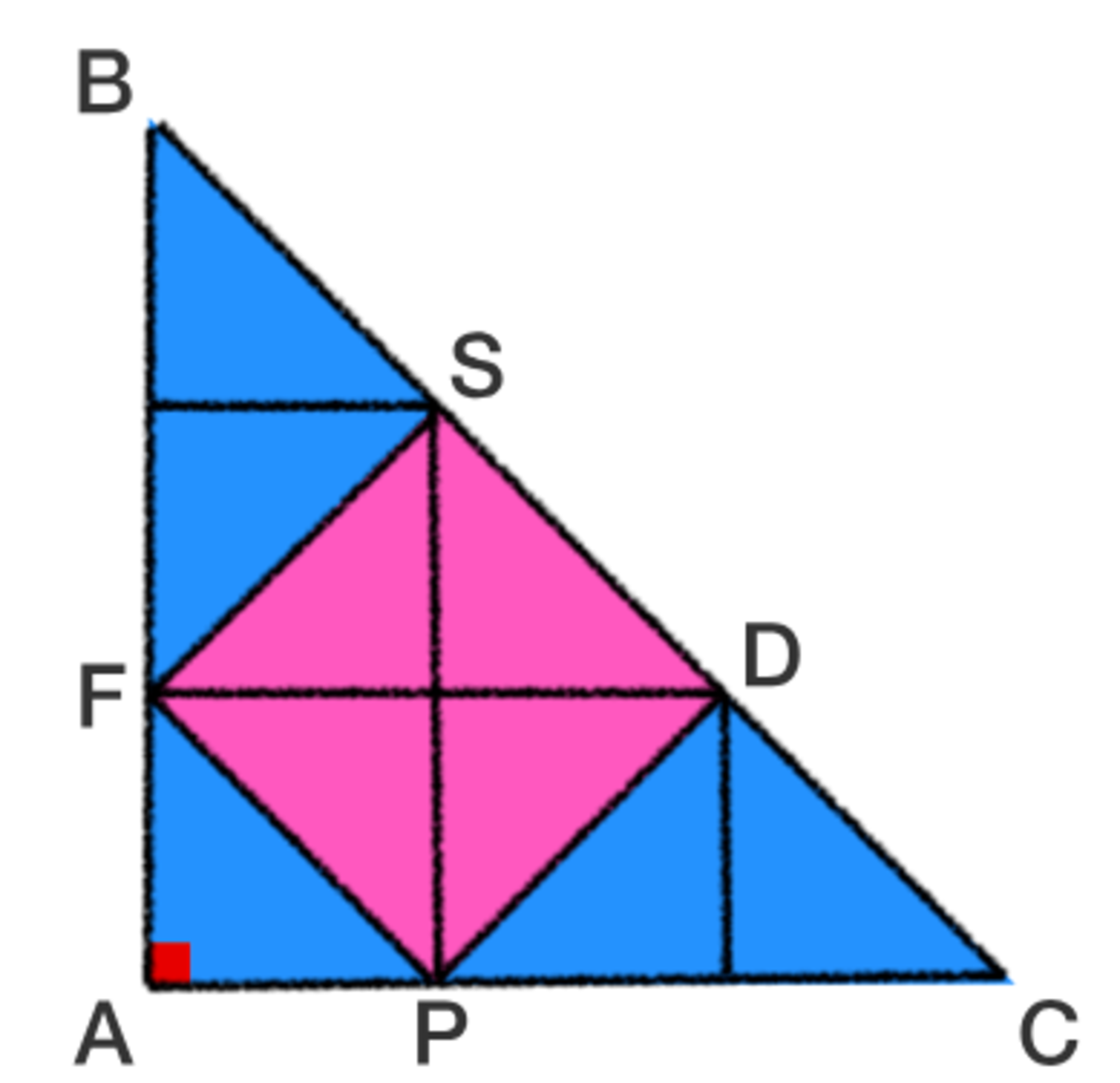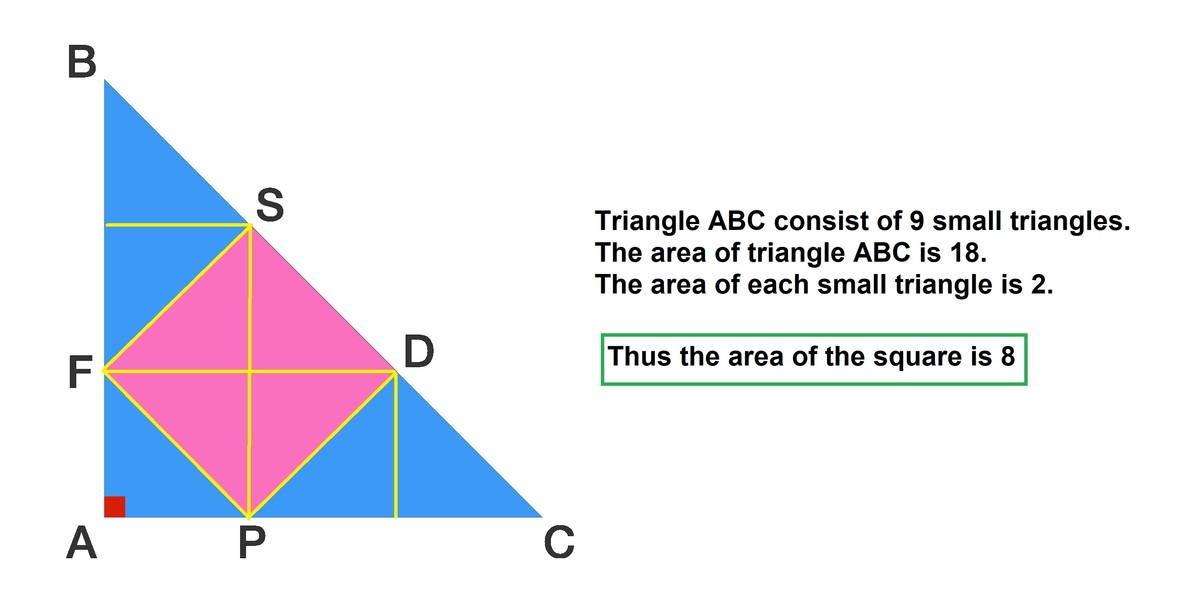Fit just nicely
A B C is an isosceles right triangle with A B = A C = 6 .
Given that S D P F is a square, find the area of the square.
The answer is 8.
This section requires Javascript.
You are seeing this because something didn't load right. We suggest you, (a) try
refreshing the page, (b) enabling javascript if it is disabled on your browser and,
finally, (c)
loading the
non-javascript version of this page
. We're sorry about the hassle.
10 solutions
x=2*(2)^0.5 not 4/(2)^0.5
Log in to reply
can you post your solution? thanks ..
side length of square = x. x sqrt{2}/2 + x sqrt{2} = 6 x sqrt{2} = 6/1.5 = 4 x = 4/sqrt{2} = 2 sqrt{2} x^2 = (2*sqrt{2})^2 = 8.
Just Genius......👌👌👌
its very easy , let SPDF have a side - x , in triangle FPC base angles each 45 because the big triangle is isosceles right angled triangle. so ,PC = FP = x similarly SD = BD = X and already PD = x BC = BD + PD + PC = 3X and by pythagorous theorem BC = 6 2 , x = 2 2 area = x 2 = 8
Nice solution! I did the same thing too. :)
I find the illustration misleading. I think the author should change "ABC=90 degrees" to m ∠ B A C = 9 0 ∘ so that it matches the figure. :)
i did it in the same way....nice solution

Since A B C is an isosceles right triangle, ∠ B = ∠ C = 4 5 ∘ . Of course, △ B S F , △ F A P , and △ P D C are isosceles right triangles too. Let A F = A P = x , by pythagorous theorem we have F P = 2 x 2 and since S D P F is a square then S F = S D = D P = 2 x 2 . Now, look at the △ P D C
( 6 − x ) 2 6 − x x = 2 x 2 + 2 x 2 = 2 x = 2
Thus, the area of the square S D P F = 2 x 2 = 8 . □
Let x = ( S A ) . Then ( S D ) = ( S F ) = 2 ∗ x , and so ( S B ) = 2 x .
Thus ( A B ) = ( S A ) + ( S B ) = x + 2 x = 3 x = 6 ⟹ x = 2 .
The square S P D F thus has sides lengths 2 ∗ x = 2 2 cm., and hence has an area of 8 c m 2 .
How SB is 2x ??
Be careful the dimensions in the drawing are unitless.

Let the side of the square be x
Since A B C is an isosceles right angled triangle, ∠ A B C = ∠ A C B = 4 5 ∘
∠ B F S = ∠ D P C = 1 8 0 ∘ − ( 9 0 ∘ + 4 5 ∘ ) = 4 5 ∘
Therefore, both B S F and P D C are isosceles triangles and B S = D C = x .
Hence, B C = B S + S D + D C = 3 x
Using Pythagoras theorem in triangle A B C ,
A B 2 + A C 2 = B C 2
6 2 + 6 2 = ( 3 x ) 2
7 2 = 9 x 2
x 2 = Area of the square S D P F = 8 square units.
Triangle BSF and Triangle PDC are both 45- 45-90 triangle, meaning it's isosceles. BS=SF & PD = DC Let them be x, so the area of the square is x^2 BS+SD+DC=3x sqrt(2*6^2)=3x x= 2 sqrt (2) x^2=8 8 is the answer.
 as you see this shape is made of 9 identical triangles. and the square is made of 4 of the triangles. the area of the triangle is 6*6/2=18. since the square takes up 4/9 of the triangle, 4/9 * 18 = 8
as you see this shape is made of 9 identical triangles. and the square is made of 4 of the triangles. the area of the triangle is 6*6/2=18. since the square takes up 4/9 of the triangle, 4/9 * 18 = 8
Triangle ABC has area 18 and can be split into nine congruent triangles (all of which are congruent to triangle AFP) each with area 2. Square FSPD is comprised of four of these triangles and therefore has area 8.
 Based from my figure, let
h
be the height and
b
be the base of the triangle
Based from my figure, let
h
be the height and
b
be the base of the triangle
Solving for the base, we have
b = 6 2 + 6 2 = 6 2
Solving for the height, we have
h = 6 2 − ( 2 6 2 ) 2 = 3 2
Now use the formula x = b + h b h (this is in reference with the figure on the left), we have
x = b + h b h = 6 2 + 3 2 ( 6 2 ) ( 3 2 ) = 2 4
Finally, the area of the square is
x 2 = ( 2 4 ) 2 = 8

x = b + h b h note: I did not include the derivation.
b = 6 2 + 6 2 = 7 2 = 6 2
h = 6 2 − ( 2 6 2 ) 2 = 1 8 = 3 2
Substitute the values on the formula.
x = 6 2 + 3 2 ( 6 2 ) ( 3 2 ) = 9 2 1 8 ( 2 ) = 9 2 3 6 = 4 2
Solving for the area, we have
x 2 = ( 2 4 ) 2 = 8